Analysis of Business Culture in International Contexts
VerifiedAdded on 2023/06/10
|22
|5797
|478
Essay
AI Summary
This essay provides a comprehensive analysis of business culture, exploring key concepts, theories, and practical applications within an international context. It examines cross-cultural moments, critical incidents, and the influential Hofstede model, including psychometric applications and individual cultural profiling. The essay further delves into wider business applications of national culture research, individual behavioral adaptation, and the challenges of culture shock. Success and failure in international assignments, culture mapping, and cross-cultural competency are also discussed, along with other national culture research models. The essay concludes by comparing national and corporate culture, introducing the Organizational Culture Inventory (OCI), and highlighting strategies for navigating cultural differences in business settings. The essay emphasizes the importance of understanding and adapting to cultural nuances for effective business operations in a globalized world.
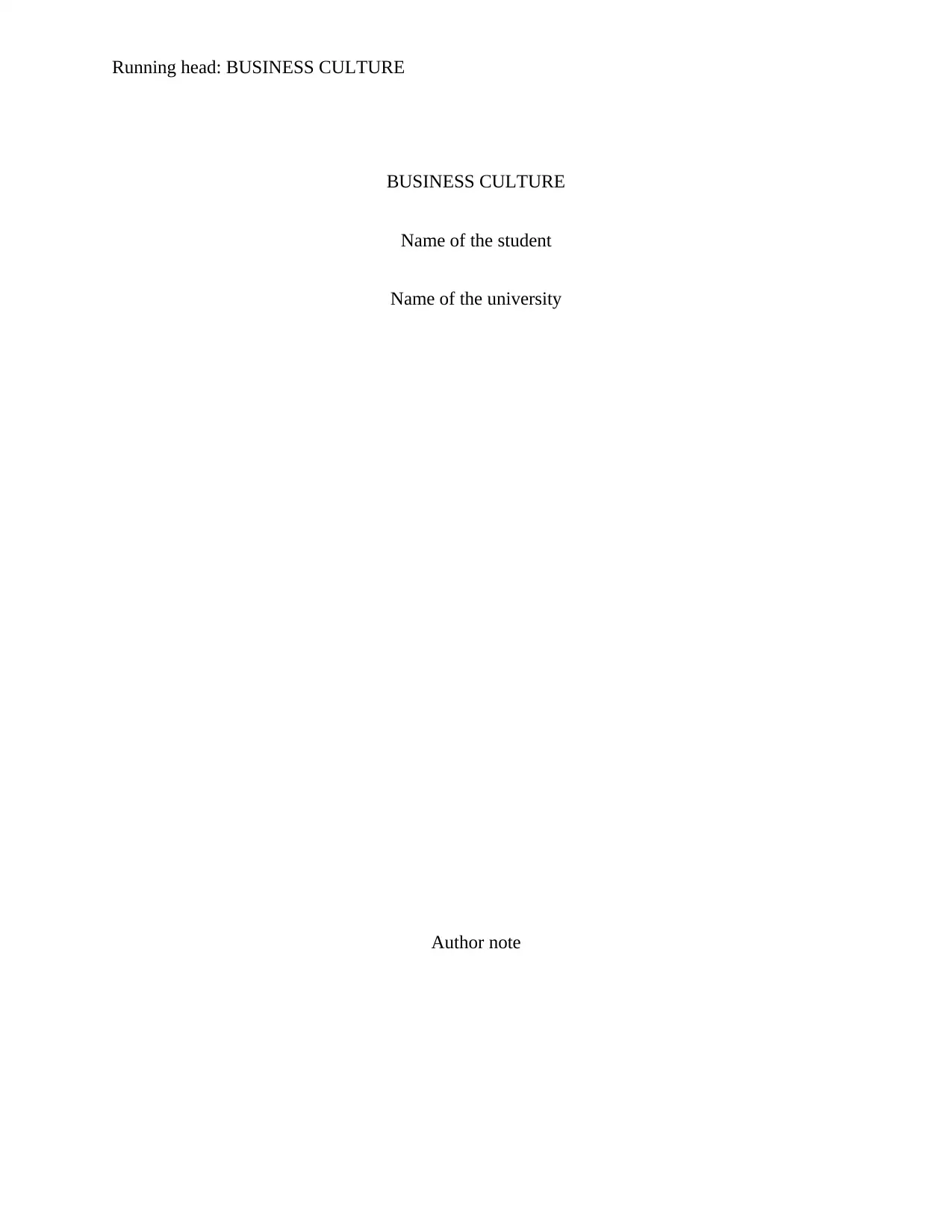
Running head: BUSINESS CULTURE
BUSINESS CULTURE
Name of the student
Name of the university
Author note
BUSINESS CULTURE
Name of the student
Name of the university
Author note
Paraphrase This Document
Need a fresh take? Get an instant paraphrase of this document with our AI Paraphraser
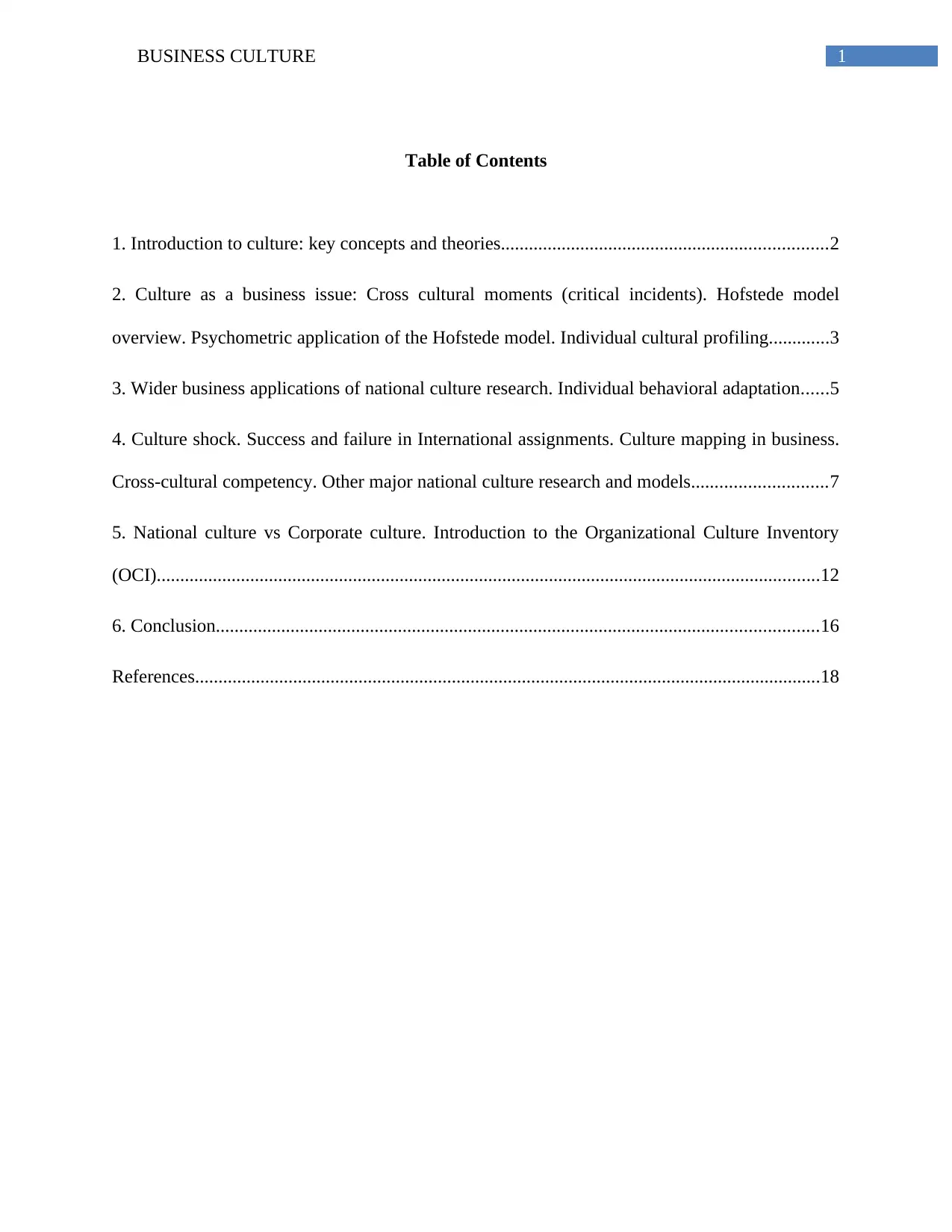
1BUSINESS CULTURE
Table of Contents
1. Introduction to culture: key concepts and theories......................................................................2
2. Culture as a business issue: Cross cultural moments (critical incidents). Hofstede model
overview. Psychometric application of the Hofstede model. Individual cultural profiling.............3
3. Wider business applications of national culture research. Individual behavioral adaptation......5
4. Culture shock. Success and failure in International assignments. Culture mapping in business.
Cross-cultural competency. Other major national culture research and models.............................7
5. National culture vs Corporate culture. Introduction to the Organizational Culture Inventory
(OCI)..............................................................................................................................................12
6. Conclusion.................................................................................................................................16
References......................................................................................................................................18
Table of Contents
1. Introduction to culture: key concepts and theories......................................................................2
2. Culture as a business issue: Cross cultural moments (critical incidents). Hofstede model
overview. Psychometric application of the Hofstede model. Individual cultural profiling.............3
3. Wider business applications of national culture research. Individual behavioral adaptation......5
4. Culture shock. Success and failure in International assignments. Culture mapping in business.
Cross-cultural competency. Other major national culture research and models.............................7
5. National culture vs Corporate culture. Introduction to the Organizational Culture Inventory
(OCI)..............................................................................................................................................12
6. Conclusion.................................................................................................................................16
References......................................................................................................................................18
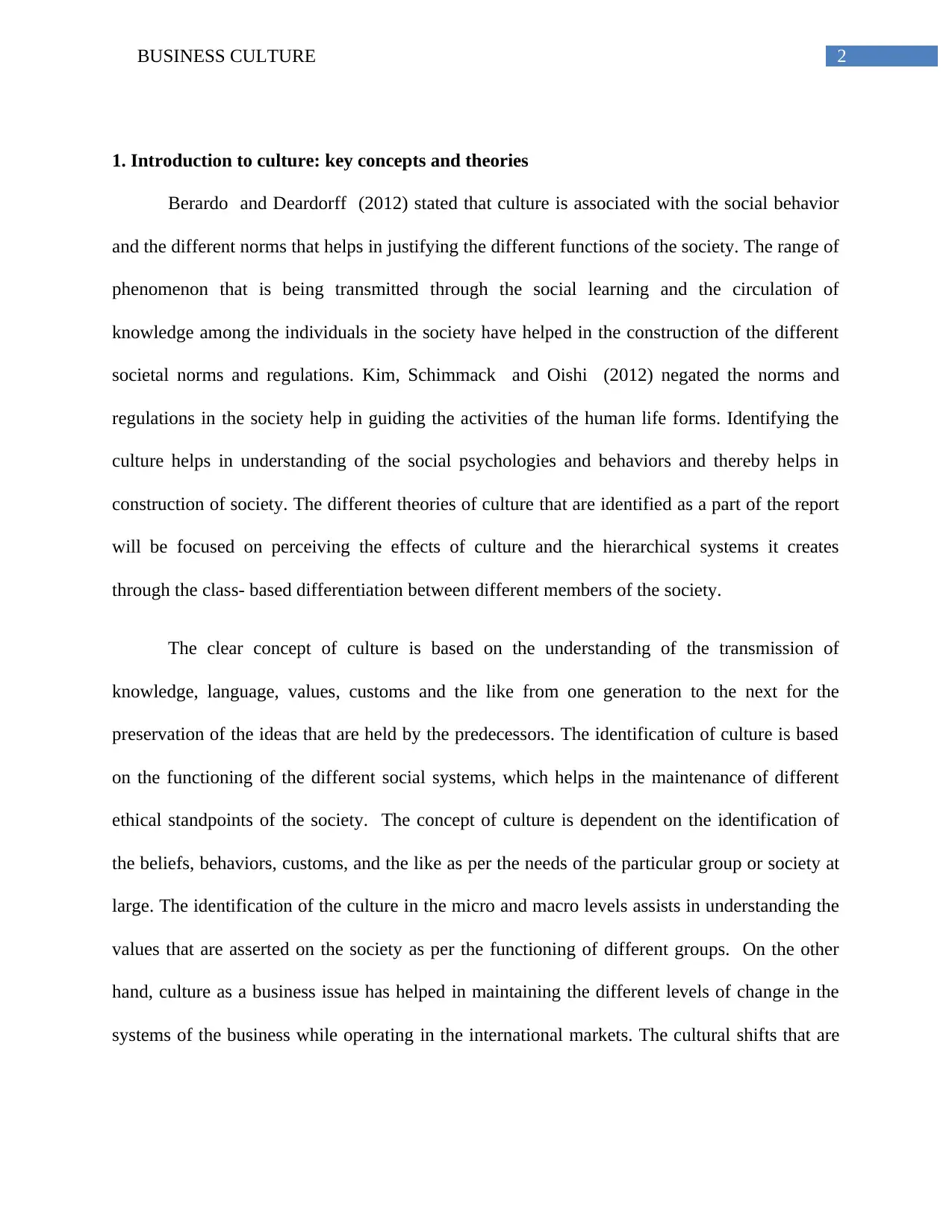
2BUSINESS CULTURE
1. Introduction to culture: key concepts and theories
Berardo and Deardorff (2012) stated that culture is associated with the social behavior
and the different norms that helps in justifying the different functions of the society. The range of
phenomenon that is being transmitted through the social learning and the circulation of
knowledge among the individuals in the society have helped in the construction of the different
societal norms and regulations. Kim, Schimmack and Oishi (2012) negated the norms and
regulations in the society help in guiding the activities of the human life forms. Identifying the
culture helps in understanding of the social psychologies and behaviors and thereby helps in
construction of society. The different theories of culture that are identified as a part of the report
will be focused on perceiving the effects of culture and the hierarchical systems it creates
through the class- based differentiation between different members of the society.
The clear concept of culture is based on the understanding of the transmission of
knowledge, language, values, customs and the like from one generation to the next for the
preservation of the ideas that are held by the predecessors. The identification of culture is based
on the functioning of the different social systems, which helps in the maintenance of different
ethical standpoints of the society. The concept of culture is dependent on the identification of
the beliefs, behaviors, customs, and the like as per the needs of the particular group or society at
large. The identification of the culture in the micro and macro levels assists in understanding the
values that are asserted on the society as per the functioning of different groups. On the other
hand, culture as a business issue has helped in maintaining the different levels of change in the
systems of the business while operating in the international markets. The cultural shifts that are
1. Introduction to culture: key concepts and theories
Berardo and Deardorff (2012) stated that culture is associated with the social behavior
and the different norms that helps in justifying the different functions of the society. The range of
phenomenon that is being transmitted through the social learning and the circulation of
knowledge among the individuals in the society have helped in the construction of the different
societal norms and regulations. Kim, Schimmack and Oishi (2012) negated the norms and
regulations in the society help in guiding the activities of the human life forms. Identifying the
culture helps in understanding of the social psychologies and behaviors and thereby helps in
construction of society. The different theories of culture that are identified as a part of the report
will be focused on perceiving the effects of culture and the hierarchical systems it creates
through the class- based differentiation between different members of the society.
The clear concept of culture is based on the understanding of the transmission of
knowledge, language, values, customs and the like from one generation to the next for the
preservation of the ideas that are held by the predecessors. The identification of culture is based
on the functioning of the different social systems, which helps in the maintenance of different
ethical standpoints of the society. The concept of culture is dependent on the identification of
the beliefs, behaviors, customs, and the like as per the needs of the particular group or society at
large. The identification of the culture in the micro and macro levels assists in understanding the
values that are asserted on the society as per the functioning of different groups. On the other
hand, culture as a business issue has helped in maintaining the different levels of change in the
systems of the business while operating in the international markets. The cultural shifts that are
⊘ This is a preview!⊘
Do you want full access?
Subscribe today to unlock all pages.

Trusted by 1+ million students worldwide
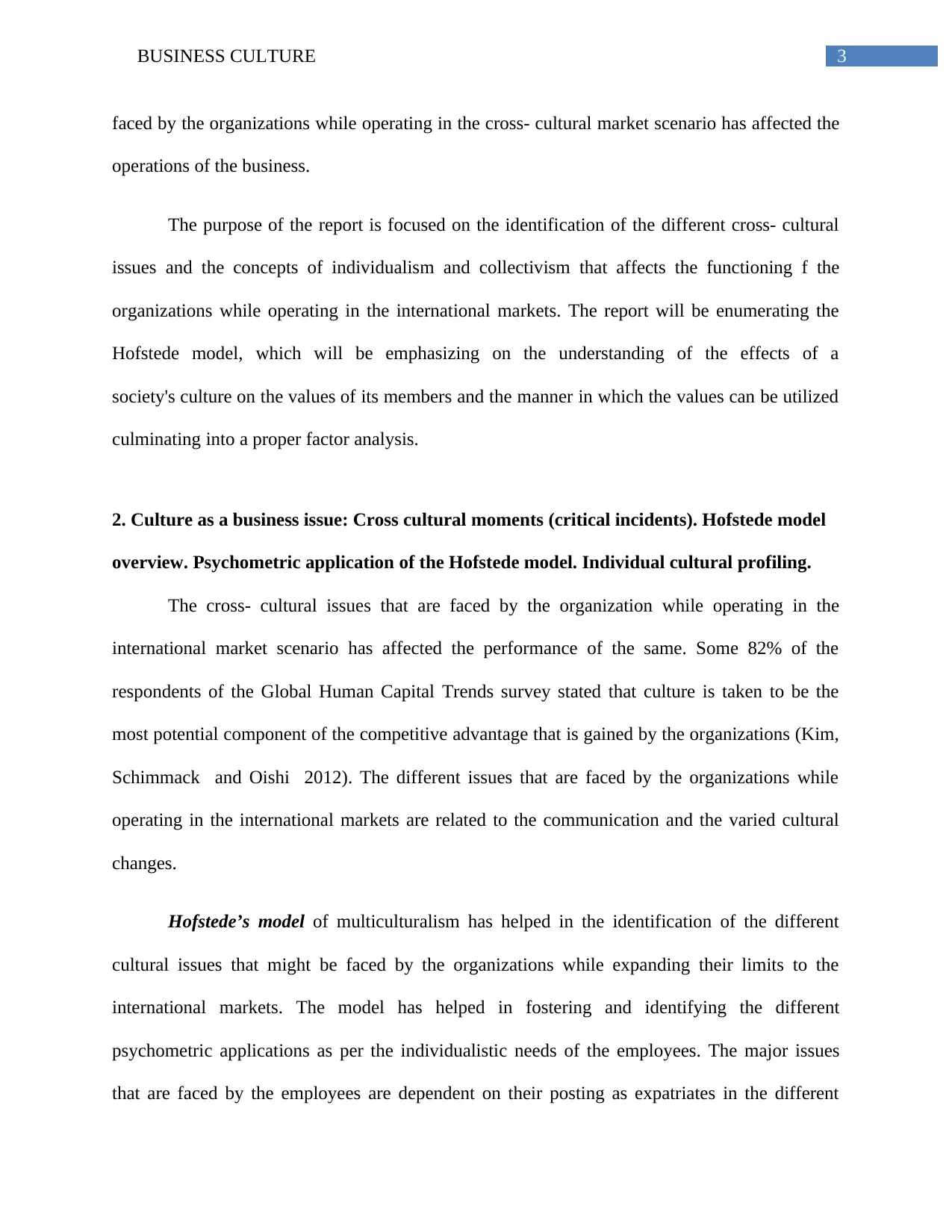
3BUSINESS CULTURE
faced by the organizations while operating in the cross- cultural market scenario has affected the
operations of the business.
The purpose of the report is focused on the identification of the different cross- cultural
issues and the concepts of individualism and collectivism that affects the functioning f the
organizations while operating in the international markets. The report will be enumerating the
Hofstede model, which will be emphasizing on the understanding of the effects of a
society's culture on the values of its members and the manner in which the values can be utilized
culminating into a proper factor analysis.
2. Culture as a business issue: Cross cultural moments (critical incidents). Hofstede model
overview. Psychometric application of the Hofstede model. Individual cultural profiling.
The cross- cultural issues that are faced by the organization while operating in the
international market scenario has affected the performance of the same. Some 82% of the
respondents of the Global Human Capital Trends survey stated that culture is taken to be the
most potential component of the competitive advantage that is gained by the organizations (Kim,
Schimmack and Oishi 2012). The different issues that are faced by the organizations while
operating in the international markets are related to the communication and the varied cultural
changes.
Hofstede’s model of multiculturalism has helped in the identification of the different
cultural issues that might be faced by the organizations while expanding their limits to the
international markets. The model has helped in fostering and identifying the different
psychometric applications as per the individualistic needs of the employees. The major issues
that are faced by the employees are dependent on their posting as expatriates in the different
faced by the organizations while operating in the cross- cultural market scenario has affected the
operations of the business.
The purpose of the report is focused on the identification of the different cross- cultural
issues and the concepts of individualism and collectivism that affects the functioning f the
organizations while operating in the international markets. The report will be enumerating the
Hofstede model, which will be emphasizing on the understanding of the effects of a
society's culture on the values of its members and the manner in which the values can be utilized
culminating into a proper factor analysis.
2. Culture as a business issue: Cross cultural moments (critical incidents). Hofstede model
overview. Psychometric application of the Hofstede model. Individual cultural profiling.
The cross- cultural issues that are faced by the organization while operating in the
international market scenario has affected the performance of the same. Some 82% of the
respondents of the Global Human Capital Trends survey stated that culture is taken to be the
most potential component of the competitive advantage that is gained by the organizations (Kim,
Schimmack and Oishi 2012). The different issues that are faced by the organizations while
operating in the international markets are related to the communication and the varied cultural
changes.
Hofstede’s model of multiculturalism has helped in the identification of the different
cultural issues that might be faced by the organizations while expanding their limits to the
international markets. The model has helped in fostering and identifying the different
psychometric applications as per the individualistic needs of the employees. The major issues
that are faced by the employees are dependent on their posting as expatriates in the different
Paraphrase This Document
Need a fresh take? Get an instant paraphrase of this document with our AI Paraphraser
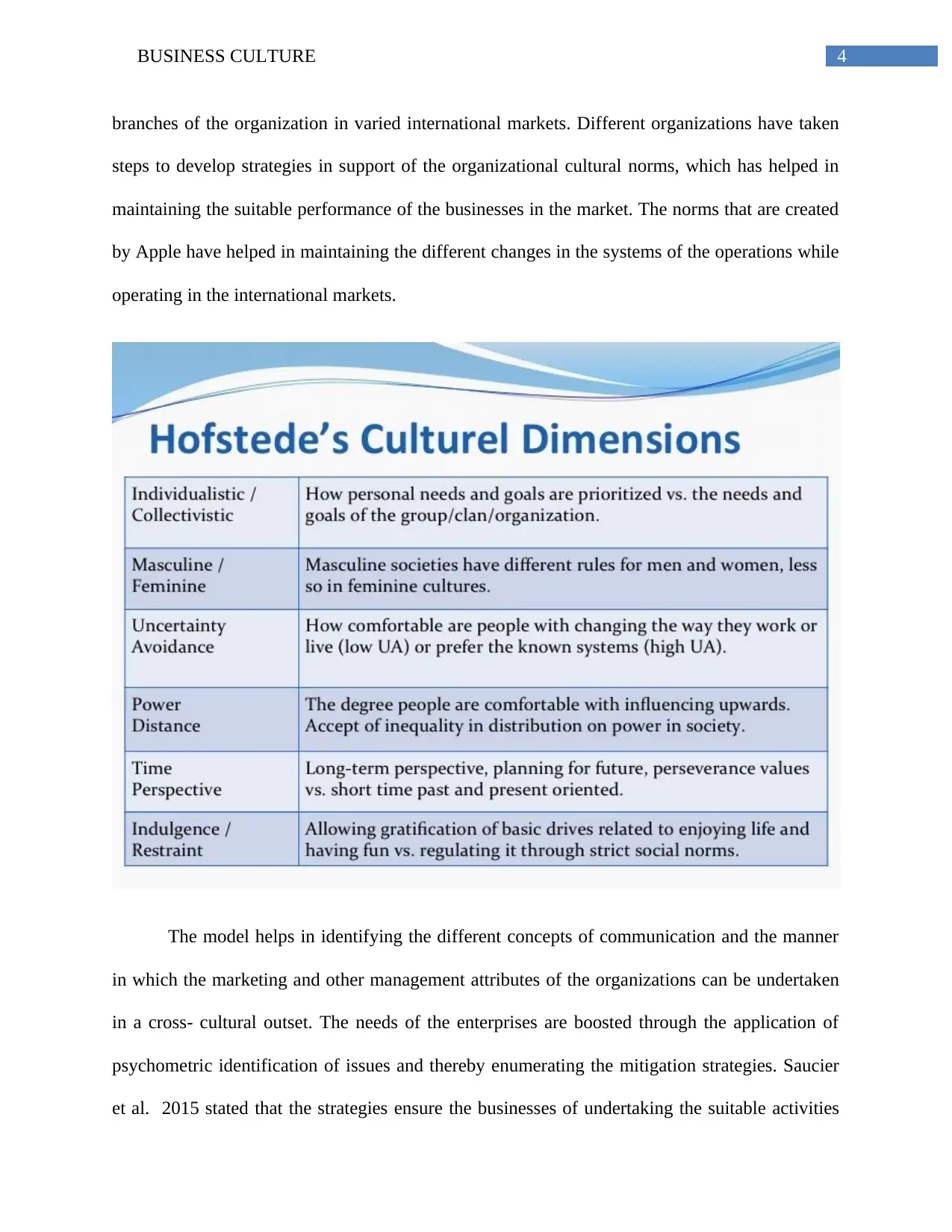
4BUSINESS CULTURE
branches of the organization in varied international markets. Different organizations have taken
steps to develop strategies in support of the organizational cultural norms, which has helped in
maintaining the suitable performance of the businesses in the market. The norms that are created
by Apple have helped in maintaining the different changes in the systems of the operations while
operating in the international markets.
The model helps in identifying the different concepts of communication and the manner
in which the marketing and other management attributes of the organizations can be undertaken
in a cross- cultural outset. The needs of the enterprises are boosted through the application of
psychometric identification of issues and thereby enumerating the mitigation strategies. Saucier
et al. 2015 stated that the strategies ensure the businesses of undertaking the suitable activities
branches of the organization in varied international markets. Different organizations have taken
steps to develop strategies in support of the organizational cultural norms, which has helped in
maintaining the suitable performance of the businesses in the market. The norms that are created
by Apple have helped in maintaining the different changes in the systems of the operations while
operating in the international markets.
The model helps in identifying the different concepts of communication and the manner
in which the marketing and other management attributes of the organizations can be undertaken
in a cross- cultural outset. The needs of the enterprises are boosted through the application of
psychometric identification of issues and thereby enumerating the mitigation strategies. Saucier
et al. 2015 stated that the strategies ensure the businesses of undertaking the suitable activities
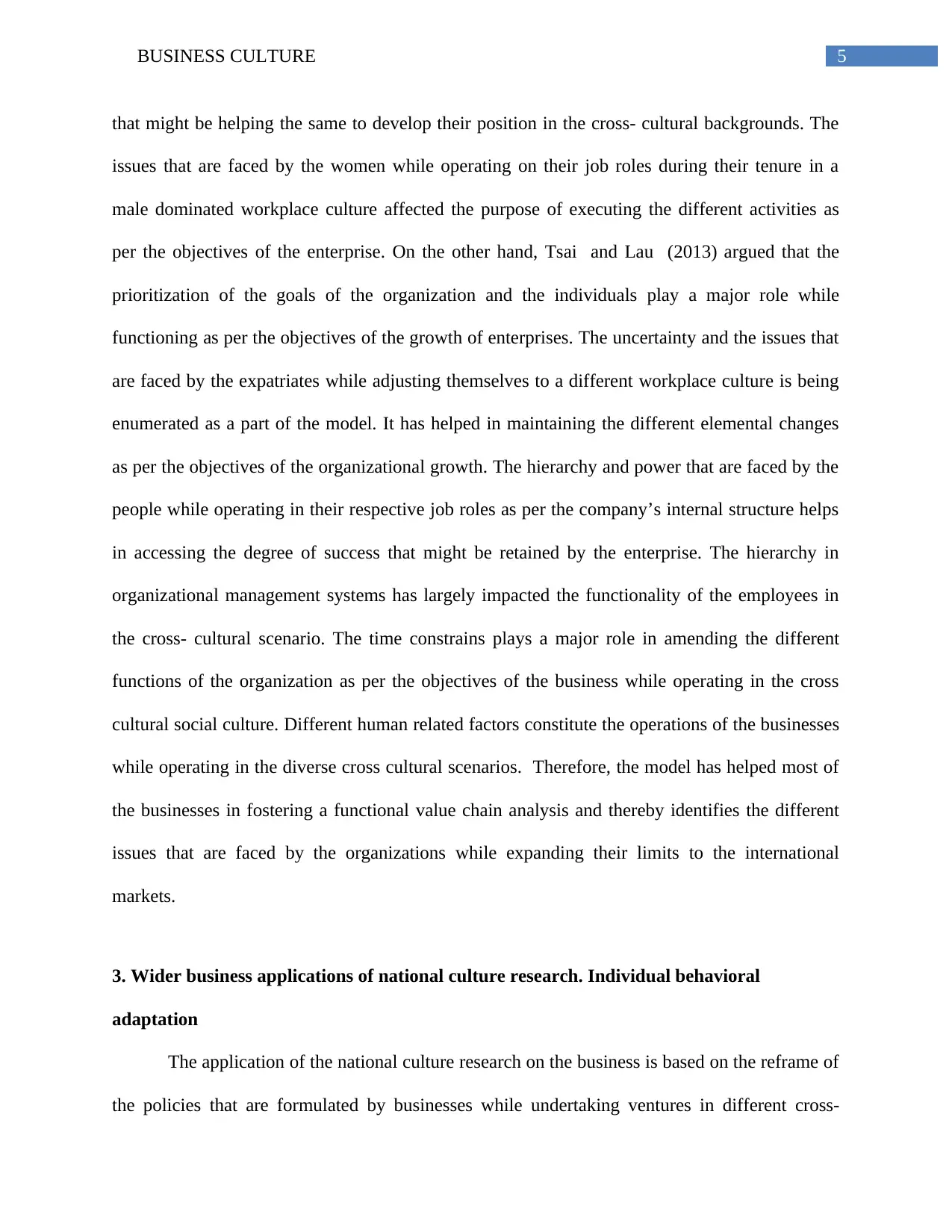
5BUSINESS CULTURE
that might be helping the same to develop their position in the cross- cultural backgrounds. The
issues that are faced by the women while operating on their job roles during their tenure in a
male dominated workplace culture affected the purpose of executing the different activities as
per the objectives of the enterprise. On the other hand, Tsai and Lau (2013) argued that the
prioritization of the goals of the organization and the individuals play a major role while
functioning as per the objectives of the growth of enterprises. The uncertainty and the issues that
are faced by the expatriates while adjusting themselves to a different workplace culture is being
enumerated as a part of the model. It has helped in maintaining the different elemental changes
as per the objectives of the organizational growth. The hierarchy and power that are faced by the
people while operating in their respective job roles as per the company’s internal structure helps
in accessing the degree of success that might be retained by the enterprise. The hierarchy in
organizational management systems has largely impacted the functionality of the employees in
the cross- cultural scenario. The time constrains plays a major role in amending the different
functions of the organization as per the objectives of the business while operating in the cross
cultural social culture. Different human related factors constitute the operations of the businesses
while operating in the diverse cross cultural scenarios. Therefore, the model has helped most of
the businesses in fostering a functional value chain analysis and thereby identifies the different
issues that are faced by the organizations while expanding their limits to the international
markets.
3. Wider business applications of national culture research. Individual behavioral
adaptation
The application of the national culture research on the business is based on the reframe of
the policies that are formulated by businesses while undertaking ventures in different cross-
that might be helping the same to develop their position in the cross- cultural backgrounds. The
issues that are faced by the women while operating on their job roles during their tenure in a
male dominated workplace culture affected the purpose of executing the different activities as
per the objectives of the enterprise. On the other hand, Tsai and Lau (2013) argued that the
prioritization of the goals of the organization and the individuals play a major role while
functioning as per the objectives of the growth of enterprises. The uncertainty and the issues that
are faced by the expatriates while adjusting themselves to a different workplace culture is being
enumerated as a part of the model. It has helped in maintaining the different elemental changes
as per the objectives of the organizational growth. The hierarchy and power that are faced by the
people while operating in their respective job roles as per the company’s internal structure helps
in accessing the degree of success that might be retained by the enterprise. The hierarchy in
organizational management systems has largely impacted the functionality of the employees in
the cross- cultural scenario. The time constrains plays a major role in amending the different
functions of the organization as per the objectives of the business while operating in the cross
cultural social culture. Different human related factors constitute the operations of the businesses
while operating in the diverse cross cultural scenarios. Therefore, the model has helped most of
the businesses in fostering a functional value chain analysis and thereby identifies the different
issues that are faced by the organizations while expanding their limits to the international
markets.
3. Wider business applications of national culture research. Individual behavioral
adaptation
The application of the national culture research on the business is based on the reframe of
the policies that are formulated by businesses while undertaking ventures in different cross-
⊘ This is a preview!⊘
Do you want full access?
Subscribe today to unlock all pages.

Trusted by 1+ million students worldwide
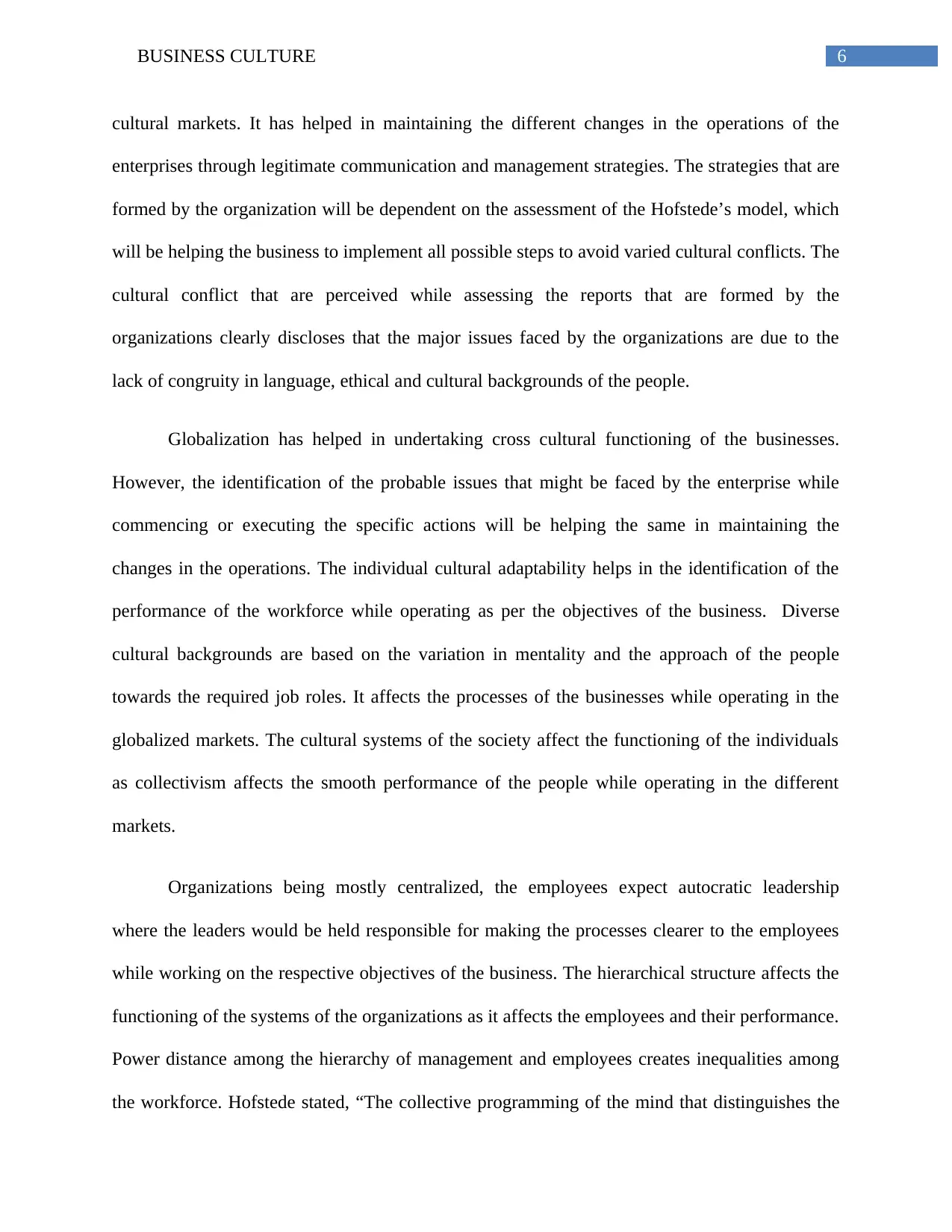
6BUSINESS CULTURE
cultural markets. It has helped in maintaining the different changes in the operations of the
enterprises through legitimate communication and management strategies. The strategies that are
formed by the organization will be dependent on the assessment of the Hofstede’s model, which
will be helping the business to implement all possible steps to avoid varied cultural conflicts. The
cultural conflict that are perceived while assessing the reports that are formed by the
organizations clearly discloses that the major issues faced by the organizations are due to the
lack of congruity in language, ethical and cultural backgrounds of the people.
Globalization has helped in undertaking cross cultural functioning of the businesses.
However, the identification of the probable issues that might be faced by the enterprise while
commencing or executing the specific actions will be helping the same in maintaining the
changes in the operations. The individual cultural adaptability helps in the identification of the
performance of the workforce while operating as per the objectives of the business. Diverse
cultural backgrounds are based on the variation in mentality and the approach of the people
towards the required job roles. It affects the processes of the businesses while operating in the
globalized markets. The cultural systems of the society affect the functioning of the individuals
as collectivism affects the smooth performance of the people while operating in the different
markets.
Organizations being mostly centralized, the employees expect autocratic leadership
where the leaders would be held responsible for making the processes clearer to the employees
while working on the respective objectives of the business. The hierarchical structure affects the
functioning of the systems of the organizations as it affects the employees and their performance.
Power distance among the hierarchy of management and employees creates inequalities among
the workforce. Hofstede stated, “The collective programming of the mind that distinguishes the
cultural markets. It has helped in maintaining the different changes in the operations of the
enterprises through legitimate communication and management strategies. The strategies that are
formed by the organization will be dependent on the assessment of the Hofstede’s model, which
will be helping the business to implement all possible steps to avoid varied cultural conflicts. The
cultural conflict that are perceived while assessing the reports that are formed by the
organizations clearly discloses that the major issues faced by the organizations are due to the
lack of congruity in language, ethical and cultural backgrounds of the people.
Globalization has helped in undertaking cross cultural functioning of the businesses.
However, the identification of the probable issues that might be faced by the enterprise while
commencing or executing the specific actions will be helping the same in maintaining the
changes in the operations. The individual cultural adaptability helps in the identification of the
performance of the workforce while operating as per the objectives of the business. Diverse
cultural backgrounds are based on the variation in mentality and the approach of the people
towards the required job roles. It affects the processes of the businesses while operating in the
globalized markets. The cultural systems of the society affect the functioning of the individuals
as collectivism affects the smooth performance of the people while operating in the different
markets.
Organizations being mostly centralized, the employees expect autocratic leadership
where the leaders would be held responsible for making the processes clearer to the employees
while working on the respective objectives of the business. The hierarchical structure affects the
functioning of the systems of the organizations as it affects the employees and their performance.
Power distance among the hierarchy of management and employees creates inequalities among
the workforce. Hofstede stated, “The collective programming of the mind that distinguishes the
Paraphrase This Document
Need a fresh take? Get an instant paraphrase of this document with our AI Paraphraser
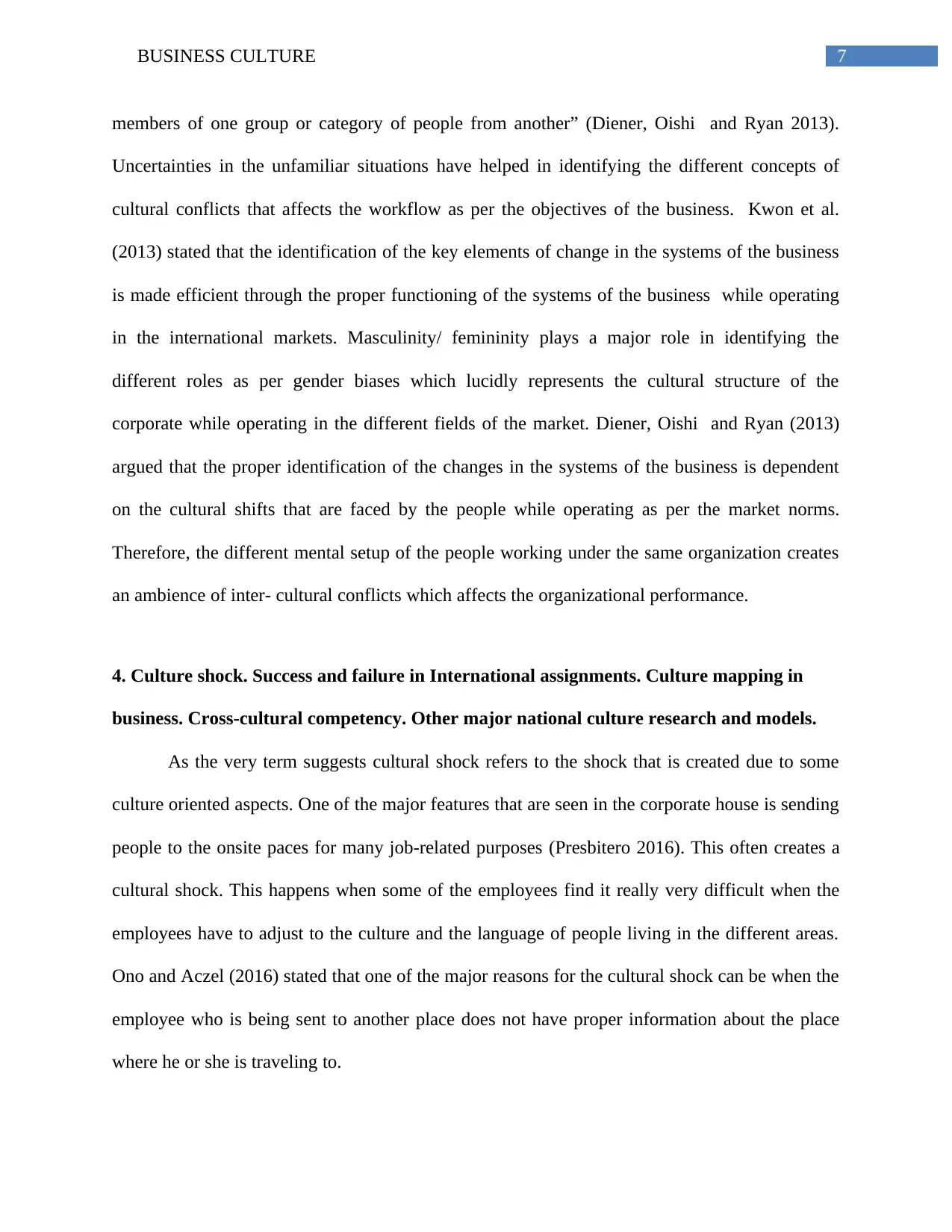
7BUSINESS CULTURE
members of one group or category of people from another” (Diener, Oishi and Ryan 2013).
Uncertainties in the unfamiliar situations have helped in identifying the different concepts of
cultural conflicts that affects the workflow as per the objectives of the business. Kwon et al.
(2013) stated that the identification of the key elements of change in the systems of the business
is made efficient through the proper functioning of the systems of the business while operating
in the international markets. Masculinity/ femininity plays a major role in identifying the
different roles as per gender biases which lucidly represents the cultural structure of the
corporate while operating in the different fields of the market. Diener, Oishi and Ryan (2013)
argued that the proper identification of the changes in the systems of the business is dependent
on the cultural shifts that are faced by the people while operating as per the market norms.
Therefore, the different mental setup of the people working under the same organization creates
an ambience of inter- cultural conflicts which affects the organizational performance.
4. Culture shock. Success and failure in International assignments. Culture mapping in
business. Cross-cultural competency. Other major national culture research and models.
As the very term suggests cultural shock refers to the shock that is created due to some
culture oriented aspects. One of the major features that are seen in the corporate house is sending
people to the onsite paces for many job-related purposes (Presbitero 2016). This often creates a
cultural shock. This happens when some of the employees find it really very difficult when the
employees have to adjust to the culture and the language of people living in the different areas.
Ono and Aczel (2016) stated that one of the major reasons for the cultural shock can be when the
employee who is being sent to another place does not have proper information about the place
where he or she is traveling to.
members of one group or category of people from another” (Diener, Oishi and Ryan 2013).
Uncertainties in the unfamiliar situations have helped in identifying the different concepts of
cultural conflicts that affects the workflow as per the objectives of the business. Kwon et al.
(2013) stated that the identification of the key elements of change in the systems of the business
is made efficient through the proper functioning of the systems of the business while operating
in the international markets. Masculinity/ femininity plays a major role in identifying the
different roles as per gender biases which lucidly represents the cultural structure of the
corporate while operating in the different fields of the market. Diener, Oishi and Ryan (2013)
argued that the proper identification of the changes in the systems of the business is dependent
on the cultural shifts that are faced by the people while operating as per the market norms.
Therefore, the different mental setup of the people working under the same organization creates
an ambience of inter- cultural conflicts which affects the organizational performance.
4. Culture shock. Success and failure in International assignments. Culture mapping in
business. Cross-cultural competency. Other major national culture research and models.
As the very term suggests cultural shock refers to the shock that is created due to some
culture oriented aspects. One of the major features that are seen in the corporate house is sending
people to the onsite paces for many job-related purposes (Presbitero 2016). This often creates a
cultural shock. This happens when some of the employees find it really very difficult when the
employees have to adjust to the culture and the language of people living in the different areas.
Ono and Aczel (2016) stated that one of the major reasons for the cultural shock can be when the
employee who is being sent to another place does not have proper information about the place
where he or she is traveling to.
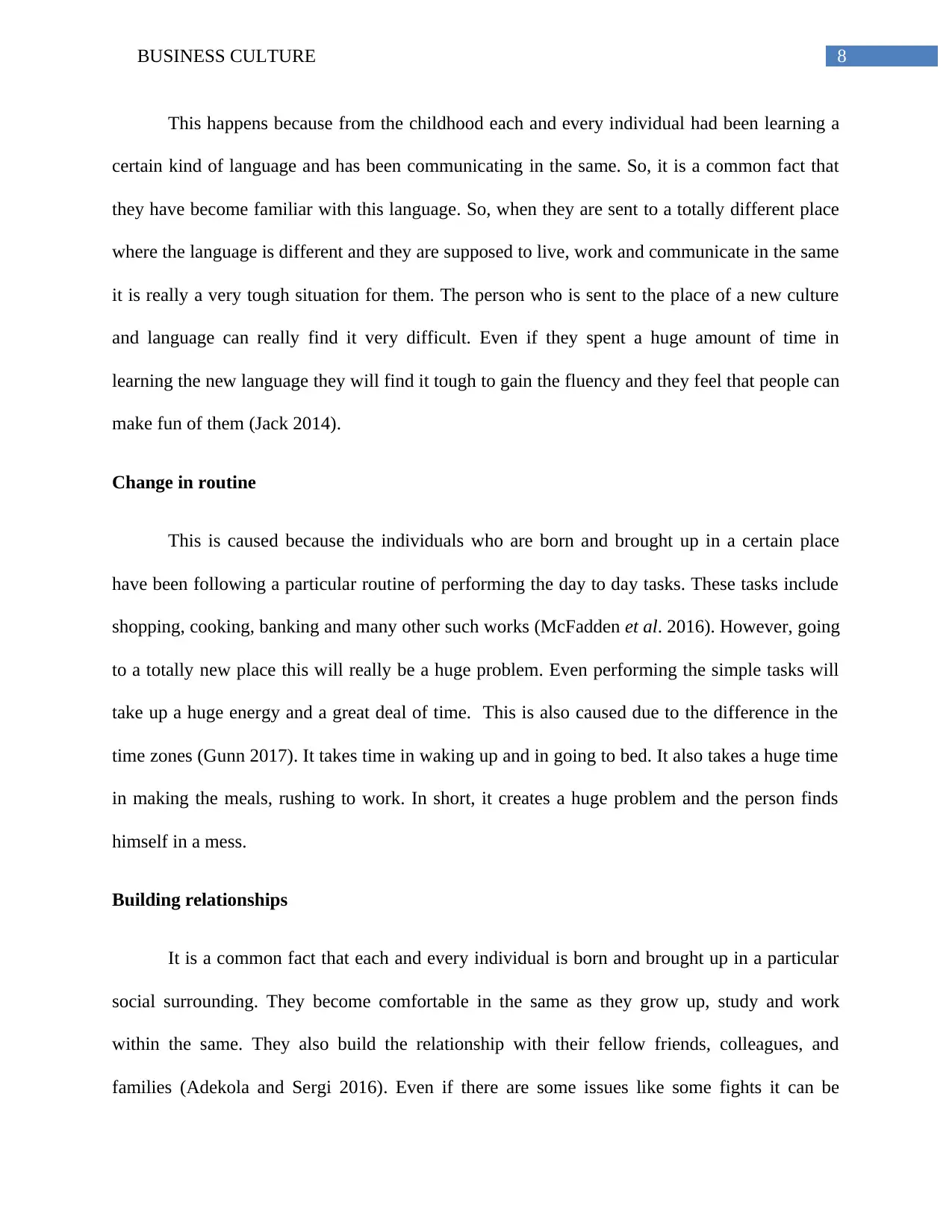
8BUSINESS CULTURE
This happens because from the childhood each and every individual had been learning a
certain kind of language and has been communicating in the same. So, it is a common fact that
they have become familiar with this language. So, when they are sent to a totally different place
where the language is different and they are supposed to live, work and communicate in the same
it is really a very tough situation for them. The person who is sent to the place of a new culture
and language can really find it very difficult. Even if they spent a huge amount of time in
learning the new language they will find it tough to gain the fluency and they feel that people can
make fun of them (Jack 2014).
Change in routine
This is caused because the individuals who are born and brought up in a certain place
have been following a particular routine of performing the day to day tasks. These tasks include
shopping, cooking, banking and many other such works (McFadden et al. 2016). However, going
to a totally new place this will really be a huge problem. Even performing the simple tasks will
take up a huge energy and a great deal of time. This is also caused due to the difference in the
time zones (Gunn 2017). It takes time in waking up and in going to bed. It also takes a huge time
in making the meals, rushing to work. In short, it creates a huge problem and the person finds
himself in a mess.
Building relationships
It is a common fact that each and every individual is born and brought up in a particular
social surrounding. They become comfortable in the same as they grow up, study and work
within the same. They also build the relationship with their fellow friends, colleagues, and
families (Adekola and Sergi 2016). Even if there are some issues like some fights it can be
This happens because from the childhood each and every individual had been learning a
certain kind of language and has been communicating in the same. So, it is a common fact that
they have become familiar with this language. So, when they are sent to a totally different place
where the language is different and they are supposed to live, work and communicate in the same
it is really a very tough situation for them. The person who is sent to the place of a new culture
and language can really find it very difficult. Even if they spent a huge amount of time in
learning the new language they will find it tough to gain the fluency and they feel that people can
make fun of them (Jack 2014).
Change in routine
This is caused because the individuals who are born and brought up in a certain place
have been following a particular routine of performing the day to day tasks. These tasks include
shopping, cooking, banking and many other such works (McFadden et al. 2016). However, going
to a totally new place this will really be a huge problem. Even performing the simple tasks will
take up a huge energy and a great deal of time. This is also caused due to the difference in the
time zones (Gunn 2017). It takes time in waking up and in going to bed. It also takes a huge time
in making the meals, rushing to work. In short, it creates a huge problem and the person finds
himself in a mess.
Building relationships
It is a common fact that each and every individual is born and brought up in a particular
social surrounding. They become comfortable in the same as they grow up, study and work
within the same. They also build the relationship with their fellow friends, colleagues, and
families (Adekola and Sergi 2016). Even if there are some issues like some fights it can be
⊘ This is a preview!⊘
Do you want full access?
Subscribe today to unlock all pages.

Trusted by 1+ million students worldwide
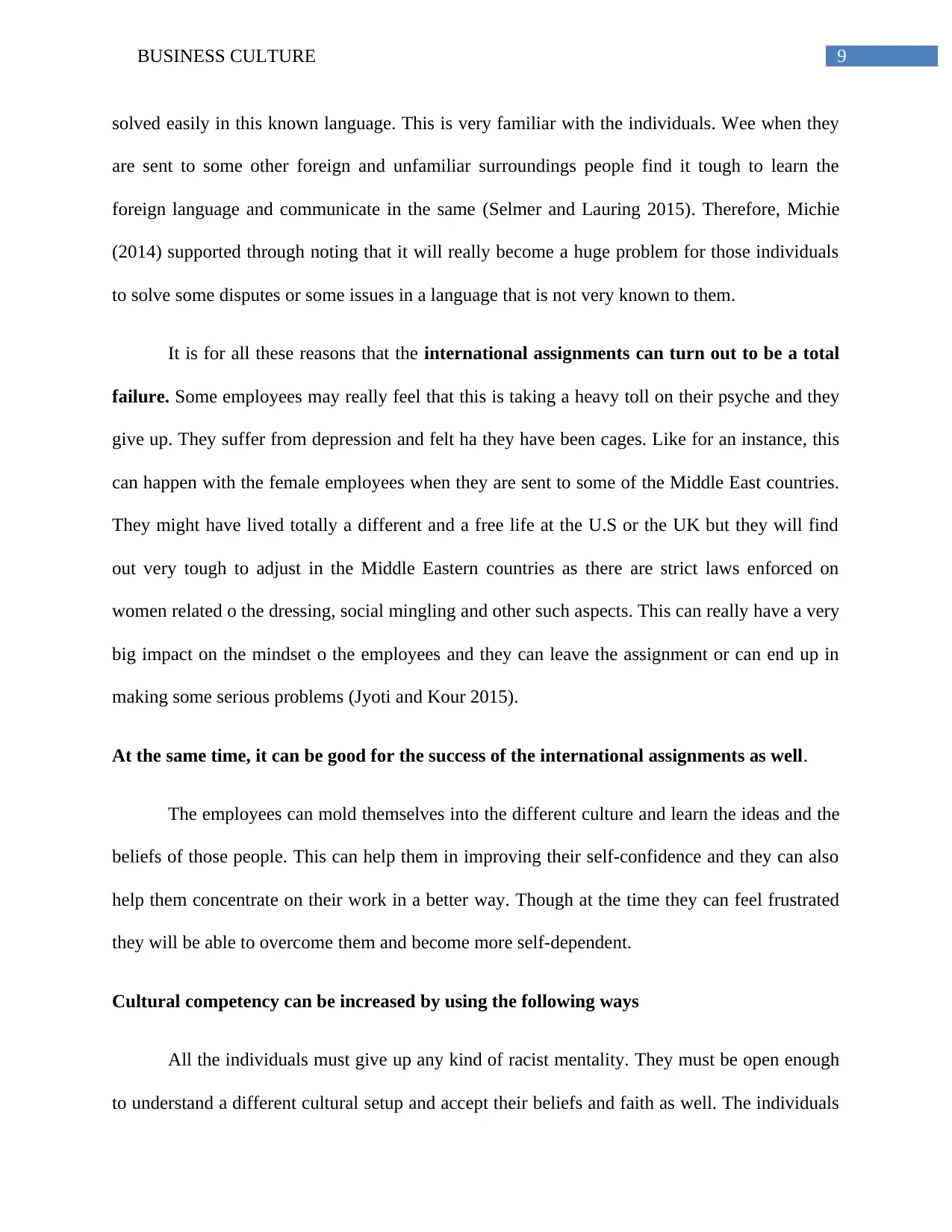
9BUSINESS CULTURE
solved easily in this known language. This is very familiar with the individuals. Wee when they
are sent to some other foreign and unfamiliar surroundings people find it tough to learn the
foreign language and communicate in the same (Selmer and Lauring 2015). Therefore, Michie
(2014) supported through noting that it will really become a huge problem for those individuals
to solve some disputes or some issues in a language that is not very known to them.
It is for all these reasons that the international assignments can turn out to be a total
failure. Some employees may really feel that this is taking a heavy toll on their psyche and they
give up. They suffer from depression and felt ha they have been cages. Like for an instance, this
can happen with the female employees when they are sent to some of the Middle East countries.
They might have lived totally a different and a free life at the U.S or the UK but they will find
out very tough to adjust in the Middle Eastern countries as there are strict laws enforced on
women related o the dressing, social mingling and other such aspects. This can really have a very
big impact on the mindset o the employees and they can leave the assignment or can end up in
making some serious problems (Jyoti and Kour 2015).
At the same time, it can be good for the success of the international assignments as well.
The employees can mold themselves into the different culture and learn the ideas and the
beliefs of those people. This can help them in improving their self-confidence and they can also
help them concentrate on their work in a better way. Though at the time they can feel frustrated
they will be able to overcome them and become more self-dependent.
Cultural competency can be increased by using the following ways
All the individuals must give up any kind of racist mentality. They must be open enough
to understand a different cultural setup and accept their beliefs and faith as well. The individuals
solved easily in this known language. This is very familiar with the individuals. Wee when they
are sent to some other foreign and unfamiliar surroundings people find it tough to learn the
foreign language and communicate in the same (Selmer and Lauring 2015). Therefore, Michie
(2014) supported through noting that it will really become a huge problem for those individuals
to solve some disputes or some issues in a language that is not very known to them.
It is for all these reasons that the international assignments can turn out to be a total
failure. Some employees may really feel that this is taking a heavy toll on their psyche and they
give up. They suffer from depression and felt ha they have been cages. Like for an instance, this
can happen with the female employees when they are sent to some of the Middle East countries.
They might have lived totally a different and a free life at the U.S or the UK but they will find
out very tough to adjust in the Middle Eastern countries as there are strict laws enforced on
women related o the dressing, social mingling and other such aspects. This can really have a very
big impact on the mindset o the employees and they can leave the assignment or can end up in
making some serious problems (Jyoti and Kour 2015).
At the same time, it can be good for the success of the international assignments as well.
The employees can mold themselves into the different culture and learn the ideas and the
beliefs of those people. This can help them in improving their self-confidence and they can also
help them concentrate on their work in a better way. Though at the time they can feel frustrated
they will be able to overcome them and become more self-dependent.
Cultural competency can be increased by using the following ways
All the individuals must give up any kind of racist mentality. They must be open enough
to understand a different cultural setup and accept their beliefs and faith as well. The individuals
Paraphrase This Document
Need a fresh take? Get an instant paraphrase of this document with our AI Paraphraser
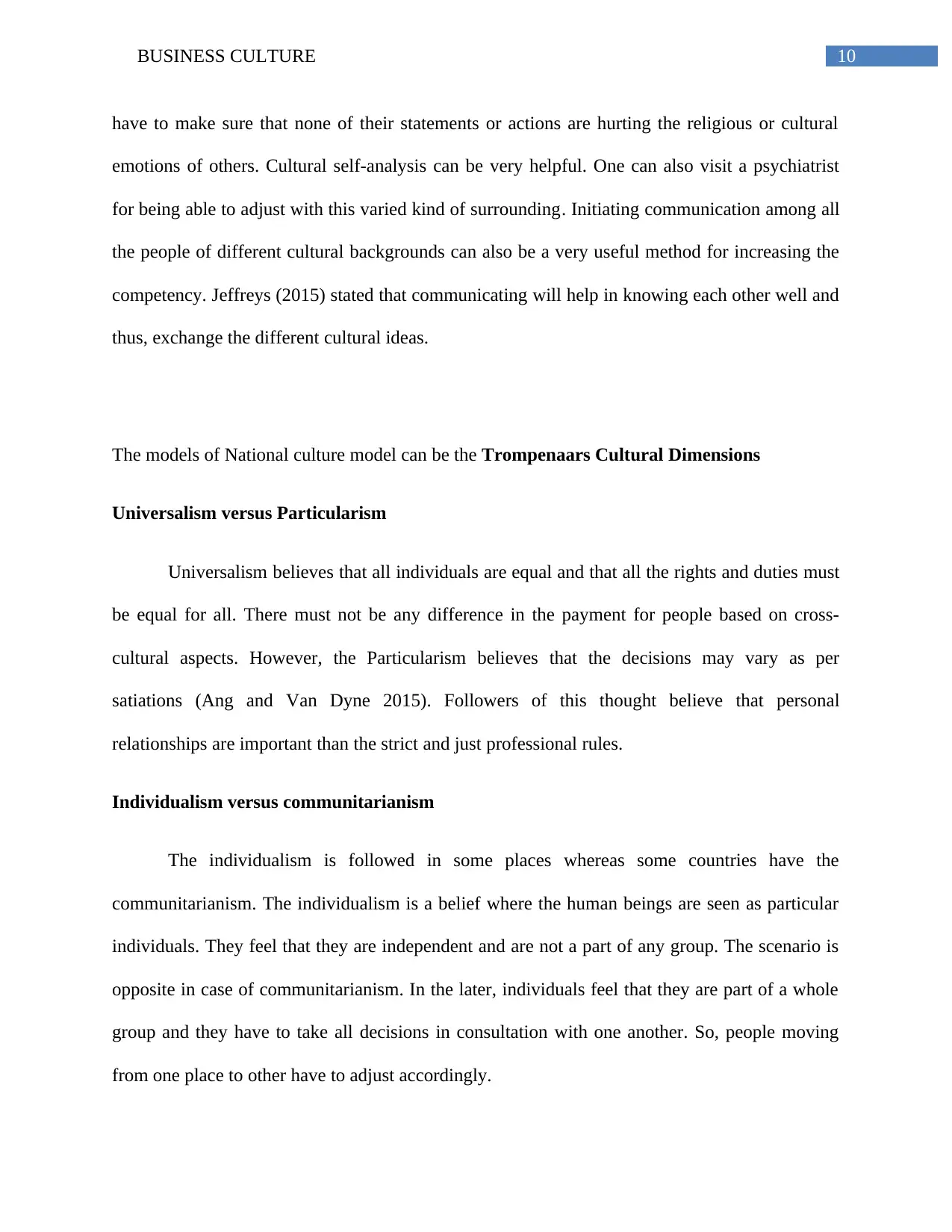
10BUSINESS CULTURE
have to make sure that none of their statements or actions are hurting the religious or cultural
emotions of others. Cultural self-analysis can be very helpful. One can also visit a psychiatrist
for being able to adjust with this varied kind of surrounding. Initiating communication among all
the people of different cultural backgrounds can also be a very useful method for increasing the
competency. Jeffreys (2015) stated that communicating will help in knowing each other well and
thus, exchange the different cultural ideas.
The models of National culture model can be the Trompenaars Cultural Dimensions
Universalism versus Particularism
Universalism believes that all individuals are equal and that all the rights and duties must
be equal for all. There must not be any difference in the payment for people based on cross-
cultural aspects. However, the Particularism believes that the decisions may vary as per
satiations (Ang and Van Dyne 2015). Followers of this thought believe that personal
relationships are important than the strict and just professional rules.
Individualism versus communitarianism
The individualism is followed in some places whereas some countries have the
communitarianism. The individualism is a belief where the human beings are seen as particular
individuals. They feel that they are independent and are not a part of any group. The scenario is
opposite in case of communitarianism. In the later, individuals feel that they are part of a whole
group and they have to take all decisions in consultation with one another. So, people moving
from one place to other have to adjust accordingly.
have to make sure that none of their statements or actions are hurting the religious or cultural
emotions of others. Cultural self-analysis can be very helpful. One can also visit a psychiatrist
for being able to adjust with this varied kind of surrounding. Initiating communication among all
the people of different cultural backgrounds can also be a very useful method for increasing the
competency. Jeffreys (2015) stated that communicating will help in knowing each other well and
thus, exchange the different cultural ideas.
The models of National culture model can be the Trompenaars Cultural Dimensions
Universalism versus Particularism
Universalism believes that all individuals are equal and that all the rights and duties must
be equal for all. There must not be any difference in the payment for people based on cross-
cultural aspects. However, the Particularism believes that the decisions may vary as per
satiations (Ang and Van Dyne 2015). Followers of this thought believe that personal
relationships are important than the strict and just professional rules.
Individualism versus communitarianism
The individualism is followed in some places whereas some countries have the
communitarianism. The individualism is a belief where the human beings are seen as particular
individuals. They feel that they are independent and are not a part of any group. The scenario is
opposite in case of communitarianism. In the later, individuals feel that they are part of a whole
group and they have to take all decisions in consultation with one another. So, people moving
from one place to other have to adjust accordingly.
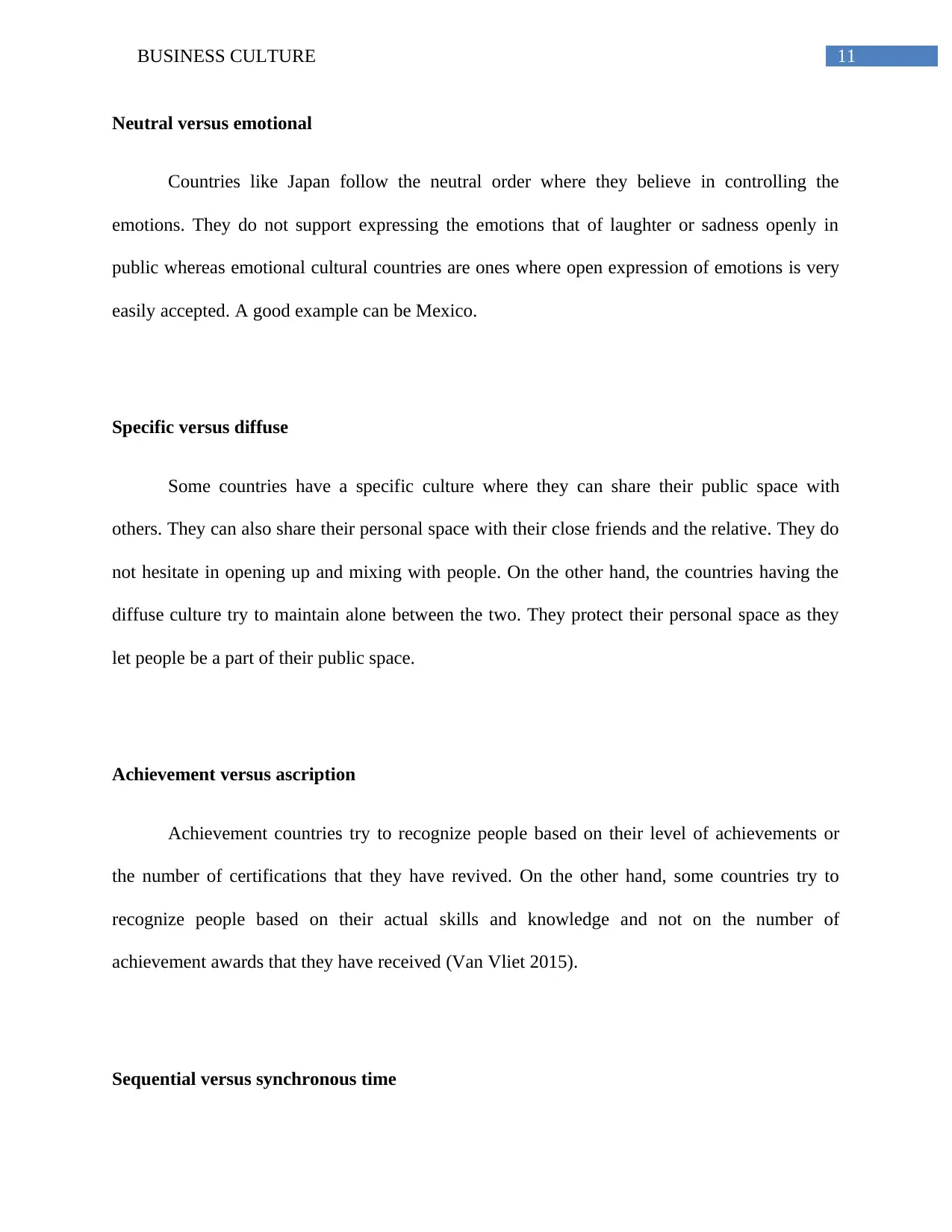
11BUSINESS CULTURE
Neutral versus emotional
Countries like Japan follow the neutral order where they believe in controlling the
emotions. They do not support expressing the emotions that of laughter or sadness openly in
public whereas emotional cultural countries are ones where open expression of emotions is very
easily accepted. A good example can be Mexico.
Specific versus diffuse
Some countries have a specific culture where they can share their public space with
others. They can also share their personal space with their close friends and the relative. They do
not hesitate in opening up and mixing with people. On the other hand, the countries having the
diffuse culture try to maintain alone between the two. They protect their personal space as they
let people be a part of their public space.
Achievement versus ascription
Achievement countries try to recognize people based on their level of achievements or
the number of certifications that they have revived. On the other hand, some countries try to
recognize people based on their actual skills and knowledge and not on the number of
achievement awards that they have received (Van Vliet 2015).
Sequential versus synchronous time
Neutral versus emotional
Countries like Japan follow the neutral order where they believe in controlling the
emotions. They do not support expressing the emotions that of laughter or sadness openly in
public whereas emotional cultural countries are ones where open expression of emotions is very
easily accepted. A good example can be Mexico.
Specific versus diffuse
Some countries have a specific culture where they can share their public space with
others. They can also share their personal space with their close friends and the relative. They do
not hesitate in opening up and mixing with people. On the other hand, the countries having the
diffuse culture try to maintain alone between the two. They protect their personal space as they
let people be a part of their public space.
Achievement versus ascription
Achievement countries try to recognize people based on their level of achievements or
the number of certifications that they have revived. On the other hand, some countries try to
recognize people based on their actual skills and knowledge and not on the number of
achievement awards that they have received (Van Vliet 2015).
Sequential versus synchronous time
⊘ This is a preview!⊘
Do you want full access?
Subscribe today to unlock all pages.

Trusted by 1+ million students worldwide
1 out of 22
Related Documents
Your All-in-One AI-Powered Toolkit for Academic Success.
+13062052269
info@desklib.com
Available 24*7 on WhatsApp / Email
![[object Object]](/_next/static/media/star-bottom.7253800d.svg)
Unlock your academic potential
Copyright © 2020–2025 A2Z Services. All Rights Reserved. Developed and managed by ZUCOL.



